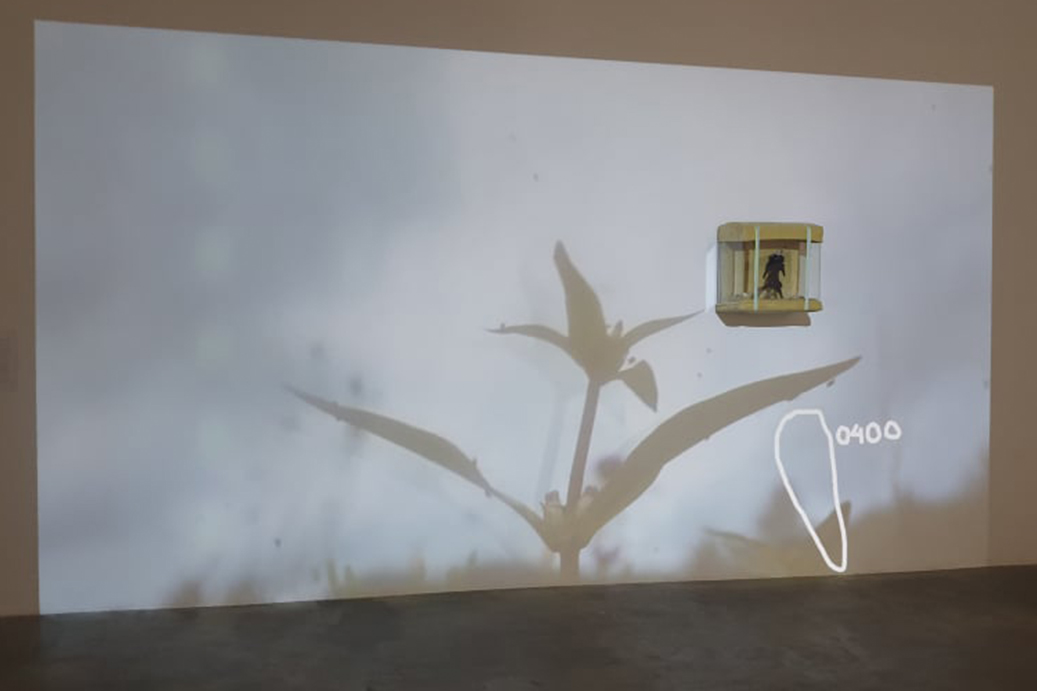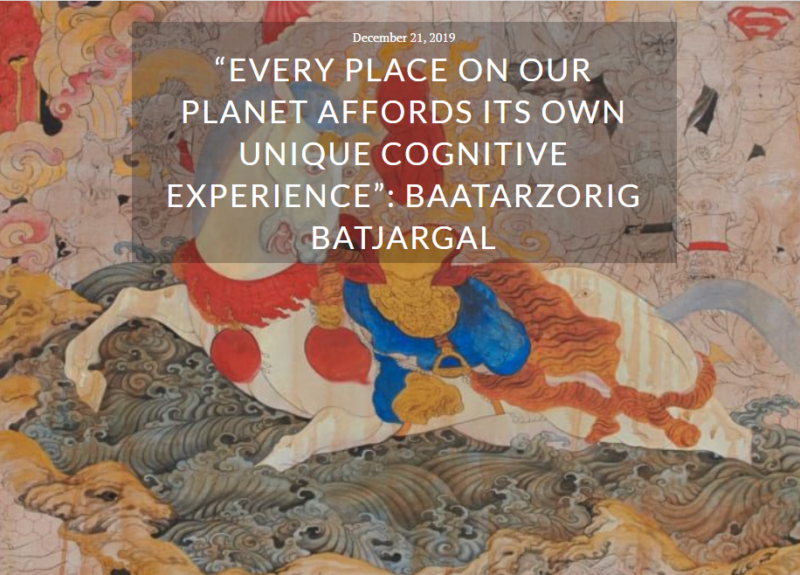
SIERRA OF CREATION
Yo.Tuguldur, G.Munkhbolor and B.Bat-Erdene
Jan 20 – Feb 1, 2020
Art Space 976 is pleased to announce the opening of joint exhibition Sierra of Creation by Tuguldur Yondonjamts, Munkhbolor Ganbold and Bat-Erdene Batchuluun. The exhibition brings together multidisciplinary works, created basing on the field trip to the archeological site and research completed in Teshig Soum of Bulgan Province, Mongolia.
In July 2019, artists made a field trip to join the team of “The Archaeology of the Tarvagatai Valley” an archaeological collaborative project between the Institute of Archaeology of the Mongolian Academy of Sciences and Yale University, which has been conducting a research since 2010 under the auspices of doctors Jargalan Burentogtokh and William Gardner. The project aims to restore lifeways and traditions of early pastoral populations at Tarvagatai Valley of Khujirt Bag at Teshig soum in Bulgan Province through examining and analyzing their material culture recovered through archaeological survey and excavation. Central to this mission has been the studies of ephemeral campsites and household structures of early nomads that have the potential to contribute significant information of domestic activities and decision-making. Lately, researchers of this project have been working on restoring the paleoclimate and environmental conditions of Teshig region, to compare the processed environmental data with the archaeological record of Tarvagatai Valley in an attempt to define if certain social and cultural decisions were associated with any climatic conditions and/or changes.
During the field visit held in Teshig Soum and for the following months, the artists developed their ideas and created works, basing on their understanding on the scientific research process and results. In 2020, the Sierra of Creation will be displayed in the United States. The project is funded by STRAX Program by The State Department and implemented by Mongolian Contemporary Art Support Association in collaboration with The Public Affairs Section (PAS) of the U.S. Embassy in Ulaanbaatar. In 2020, the exhibition will also be displayed in the United States.
Artists: Tuguldur Yondonjamts, Munkhbolor Ganbold and Bat-Erdene Batchuluun
Curator: Gantuya Badamgarav
Supporter: STRAX Program funded by U.S. State Department
Уран бүтээлч Ё.Төгөлдөр, Г.Мөнхболор, Б.Бат-Эрдэнэ нарын Бүтээлийн Нуруу нэртэй үзэсгэлэн нээлтээ хийлээ. Эдгээр уран бүтээлчид нь Булган аймгийн Тэшиг суманд хийж буй археологийн судалгааны газар биеэр очиж судалгаа хийж ирээд тууривсан видео болон өрөг урлагийн бүтээлүүдээ үзэсгэлэнд дэлгэж байна.
2019 оны 7 дугаар сард уран бүтээлчид АНУ-ын Йелийн Их Сургуулийн Доктор Уилльям Гарднер, Доктор Бүрэнтогтохын Жаргалан нарын удирдлаган дор 2010 оноос эхлэн хэрэгжиж буй Шинжлэх Ухааны Академийн Археологийн хүрээлэн, Йелийн их сургуулийн хамтарсан “Тарвагатайн хөндийн археологийн судалгаа” төсөлтэй танилцахаар явсан юм. Уг төсөл нь Булган аймгийн Тэшиг сумын Хужирт багийн нутаг Тарвагатайн голын хөндийд хэрэгжиж буй. Судлаачид археологийн судалгаа, малтлагааны үр дүнд олдсон эд өлгийн хэрэглэгдэхүүнийг шинжиж дүгнэх замаар тус хөндийд амьдарч байсан эртний нүүдэлчдийн амьдралын хэв маяг, аж ахуйг тодорхойлох зорилготой ба бууц газар, гэр бүлийн бүтэц зэрэг дээр тулгуурлан тухайн орон нутгийн үйл ажиллагаа, аливаа шийдвэрт тэдний оролцоо ямар байсныг тодорхойлоход чиглэн ажиллаж байна. Мөн сүүлийн жилүүдэд судлаачид Тэшиг хавийн эртний цаг уур, хүрээлэн буй орчин ямар байсныг тогтоохоор ажиллаж байгаа билээ. Тэрээр цаг уурын хэрэглэгдэхүүнээс боловсруулсан мэдээллийг археологийн судалгааны үр дүнтэй харьцуулснаар нүүдэлчид цаг агаар, хүрээлэн буй орчны өөрчлөлтөнд нийгэм болон соёлын асуудлаар аливаа хариу шийдэл гаргаж байсан эсэхийг олж тогтоохыг зорьж байгаа аж.
Уран бүтээлчид Тэшиг суманд хийгдэж буй археологийн судалгааны арга барил, үйл явцыг үзэж, судалсны үндсэн дээр хэдэн сарын туршид санаагаа боловсруулж бүтээлээ тууриван Бүтээлийн Нуруу үзэсгэлэнд дэлгэн үзүүлж байна. Тус үзэсгэлэн 2020 онд АНУ-д олон нийтийн хүртээл болно. Энэхүү төслийг АНУ-ын Төрийн Департментын STRAX хөтөлбөрийн санхүүжилттэйгээр АНУ-ын ЭСЯ-ны Олон нийттэй харилцах алба, Монголын орчин үеийн урлагийг дэмжих холбоотой хамтран хэрэгжүүлж байна. Энд дэлгэгдсэн бүтээлүүдийн үзэсгэлэнг 2020 онд АНУ-д гаргахаар төлөвлөж байгаа юм.
Уран бүтээлчид: Ё.Төгөлдөр, Г.Мөнхболор, Б.Бат-Эрдэнэ
Куратор: Бадамгаравын Гантуяа
Дэмжигч: АНУ-ын ЭСЯ, АНУ-ын Төрийн Департментын STRAX хөтөлбөр
SITE TRAVEL PHOTO
ARTWORKS DISPLAYED
EMPTY
Artist Bat-Erdene Batchuluun
Video 3.10 min
Installation made of cotton wire
Once archaeologist Jargalan pointed layers of excavation and said
human nature
human nature
human nature
The idea of this work is based on this conversation.
Human actions, lives and traces disappear in the nature …
And new once appear and disappear again …
THE WIND OF TIME
Artist Munkhbolor Ganbold (Munkkh)
Video 1.30 min
Edited by Dorjkhand Davaa
Bulgan aimag, Teshig soum, Tarvagatai valley, height 995, latitude 49.7651, longitude 103.305, archaeological team, insectologists, wood researchers and artists …
There our quest continues …
What can we find in this specific space or a circumstance?
Any archaeological findings, new species of insects, or extraordinary works of art? Relaxation in nature or a warm feeling you get from companions?
Ancestors spirit, the orb, the insects, the plants, the thoughts, the dreams, the temporal, the attempts to grasp all these turn into a question.
But from there the quest continues.
STRUCTURAL OBSERVATION OF THE VALLEY OF MARMOTS, 2019
Artist Tuguldur Yondonjamts
Video with sound, 11:09min
Archeologists have been doing their exploration on more than 30 sites over last 5 years. Their goal or interest is more focused to identify how average households were functioning. The majority of findings are dated to Uigur period (approximately 600 AD). Very well minimalistic mastered iron jewelry, pottery sites, bone tools are only observed parts by artists of larger accumulation done by archeologists, who’s work will give an another story of Mongolian history in the future. The systematic methodology of scientists of reading nature was interesting for my art project. Layers of time, involvement of natural events preserved by harsh climate is a given information that I used in my work.

 ON ART AND AESTTETICS interview with Baatarzorig Batjargal
ON ART AND AESTTETICS interview with Baatarzorig Batjargal

